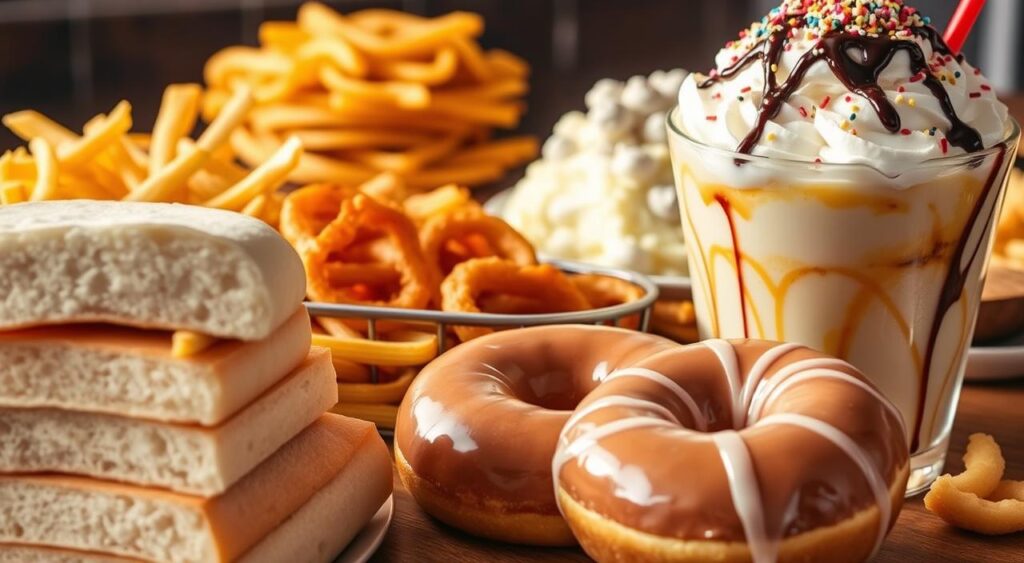Ever thought about how changing your diet could improve your health, like managing diabetes? With over 500 million people worldwide dealing with diabetes, picking the right foods is key. A low carb diet, with less than 130 grams of carbs daily, helps control blood sugar levels.
In this article, we’ll cover the basics of a low carb diet for diabetics. We’ll talk about the foods you should eat and those to avoid. Plus, we’ll explain why this diet is so good for managing diabetes.
Understanding Diabetes and Its Impact on Dietary Choices
Diabetes is a long-term condition that changes how our body uses glucose, our main energy source. Knowing the types of diabetes, like type 1 and type 2, is key to managing it with diet. Type 1 diabetes usually needs insulin to control blood sugar. Type 2 diabetes can often be managed by changing your lifestyle, including what you eat.
Insulin is very important for keeping blood sugar levels right. If insulin is not made or used right, glucose stays in the blood. This can cause health problems. Choosing the right foods is a big part of managing diabetes and staying healthy.
Good food choices can really help avoid diabetes problems. Eating well helps control blood sugar and improves health. The American Diabetes Association says it’s important to have a meal plan that fits your tastes and health needs. This is a big part of managing diabetes with diet.
In short, healthy food choices can help control blood sugar and lower diabetes risks. With the right diet, you can keep your health in check and feel your best.
What is a Low Carb Diet?
A low carb diet means eating less than 130 grams of carbs a day. It’s about making better food choices, not cutting out carbs completely. Knowing what a low carb diet is helps you pick the right foods within your carb limit.
Low carb eating lets you enjoy many foods. You can eat lots of protein and healthy fats like eggs, lean meats, avocados, and nuts. But, you should eat less of foods high in carbs, like bread, pasta, and sweets.
Here’s a quick look at some common foods and their carb content:
| Food Item | Carbohydrates (grams per serving) |
|---|---|
| 1 slice of whole grain bread | 15 |
| 1 medium banana | 27 |
| 1 cup of broccoli | 6 |
| 3 oz. of grilled chicken | 0 |
Low carb diets work well for many people. But, remember, what’s right for someone else might not be right for you. Your diet should match your health goals and lifestyle.
Why a Low Carb Diet for Diabetics is Effective
A low carb diet is great for people with diabetes. It helps lower blood sugar levels and improves health. Studies show it can greatly help manage diabetes, making it a good choice for controlling the condition.
This diet reduces insulin levels, improving how well your body uses insulin. With fewer carbs, you need less insulin. This helps keep your blood sugar stable all day.
But there’s more to it than just blood sugar. Many people lose weight and feel more energetic. Eating more proteins and healthy fats makes you feel full and gives you energy. This avoids the blood sugar spikes from high-carb foods.
How Carbohydrates Affect Blood Sugar Levels
It’s important to know how carbs affect blood sugar, which is key for managing diabetes. When you eat carbs, your body turns them into glucose, a type of sugar. This sugar then goes into your blood, affecting your blood sugar levels. So, picking the right carbs is critical.
Carbs can have different effects on blood sugar. Simple carbs, like those in candy and sugary drinks, can quickly raise blood sugar. On the other hand, complex carbs, such as whole grains and legumes, digest slowly. This leads to a gradual increase in blood sugar.
Fiber is a special case. Even though it’s a carb, fiber doesn’t raise blood sugar like other carbs do. Foods rich in fiber, like veggies and whole grains, help keep blood sugar stable. They’re good choices for anyone watching their carb intake.
When it comes to diabetes, it’s not just about how many carbs you eat but the quality of those carbs. Eating whole, unprocessed foods gives you important nutrients and helps control blood sugar. Choosing high-quality carbs is essential for managing diabetes well.
Low Carb Diet for Diabetics: Key Benefits
The benefits of low carb diet for diabetics are many and important. One big plus is weight loss. Cutting down on carbs often means losing weight, which helps your body use insulin better. This can make managing diabetes easier.
Another key advantage is better blood sugar control. A low carb diet helps keep blood sugar steady, which is key for diabetics. It reduces the big jumps in blood sugar that happen after eating carbs.
Also, eating fewer carbs can mean needing less diabetes medicine. Some research shows people on a low carb diet might need less insulin or oral meds. This can lead to fewer side effects and more freedom from medication.
There are also low carb diet advantages for your heart. Eating less carbs can improve your cholesterol, lowering bad cholesterol and raising good cholesterol. This can greatly reduce the risk of heart disease, a big worry for diabetics.
| Benefit | Description |
|---|---|
| Weight Loss | Reducing carb intake often leads to weight loss, improving insulin sensitivity. |
| Blood Sugar Management | More stable blood sugar levels due to lower spikes post-meal. |
| Reduced Medication Dependency | May require less insulin or medication, providing more flexibility. |
| Improved Cholesterol Levels | Lower triglycerides and increased HDL cholesterol reduce heart disease risk. |
Choosing a low carb lifestyle can bring many health benefits for diabetics. It helps with daily care and long-term health goals.
Optimal Carb Intake for Diabetic Individuals
Finding the right amount of carbs for diabetics can be different for everyone. Each person’s body reacts in its own way to carbs. Some say to keep carbs around 20 grams a day for good blood sugar control. Others suggest a range of 70 to 90 grams, giving you room to adjust based on your body and lifestyle.
It’s important to watch your blood sugar levels before and after meals. This helps you see how carbs affect you. By paying attention to these levels, you can find what works best for you. Creating a plan that fits your diet and health goals is key to managing blood sugar and feeling better overall.

Foods to Eat on a Low Carb Diet
Choosing the right foods is key when you’re on a low carb diet. Focus on proteins, healthy fats, and non-starchy veggies. These can make your meals better and help control diabetes.
Protein Sources
It’s important to pick the right proteins for diabetics. Go for lean meats like chicken and turkey. Fatty fish like salmon and mackerel are also good. Eggs are another great choice.
These protein sources for diabetics help keep muscles strong. They also make you feel full, so you’re less likely to snack on carbs.
Healthy Fats
Adding healthy fats for diabetes is good for your heart. Avocados, nuts, and olive oil are must-haves. They help lower cholesterol and keep you full.
Try drizzling olive oil on salads or snacking on almonds. It can really help with meal planning.
Non-Starchy Vegetables
Fill your plate with veggies that are low in carbs but full of nutrients. Spinach, broccoli, cauliflower, and zucchini are great choices. They add volume and nutrients without raising blood sugar.
Adding these veggies to your foods to eat on a low carb diet makes your meals colorful and nutritious.
| Food Category | Examples | Benefits |
|---|---|---|
| Protein Sources | Chicken, Fish, Eggs | Supports muscle maintenance, helps in satiety |
| Healthy Fats | Avocados, Nuts, Olive Oil | Improves heart health, enhances saturation |
| Non-Starchy Vegetables | Spinach, Broccoli, Zucchini | Rich in vitamins, low in carbs |
These foods offer a balanced approach to a low carb diet. By focusing on quality proteins, healthy fats, and veggies, you can enjoy satisfying meals. These meals meet your dietary needs and help manage diabetes.
Learn more about a meal plan for prediabetes reversal in 30 days.
Foods to Avoid on a Low Carb Diet
Choosing the right foods is key when you’re on a low carb diet, which is great for managing diabetes. Knowing which foods to avoid on low carb diet can really help keep your blood sugar in check. By avoiding high-carb foods, you can better manage your diabetes.
High-Carb Foods
Some foods are high in carbs and can raise your blood sugar. It’s best to cut down or avoid these:
- Bread
- Pasta
- Fried foods
- Pastries and desserts
- Sweetened beverages
These foods can cause your blood sugar to spike quickly. This makes it hard to keep your levels stable.
Processed Foods
Processed foods often have hidden sugars and unhealthy fats. Ingredients like high fructose corn syrup and trans fats can make managing blood sugar harder. Here are some processed foods to avoid:
- Snack bars
- Sugary cereals
- Condiments with added sugars
- Ready-made meals
Avoiding these foods can greatly improve your health. Opting for whole, unprocessed foods gives you better nutrition without the extra carbs.

| Type of Food | Examples | Reason to Avoid |
|---|---|---|
| High-Carb Foods | Bread, Pasta, Sugary Snacks | Can cause blood sugar spikes |
| Processed Foods | Snack Bars, Sugary Cereals | Contain hidden sugars and unhealthy fats |
Sample Low Carb Meal Plan for Diabetics
Creating a low carb meal plan for diabetes can help manage blood sugar better. It also keeps your meals tasty. Here’s a sample plan with balanced meals and healthy ingredients. It’s easy to follow a diabetic-friendly meal plan every day.
| Meal | Menu | Carbohydrate Content |
|---|---|---|
| Breakfast | Scrambled eggs with spinach and cheese | 5g |
| Snack | Celery sticks with almond butter | 4g |
| Lunch | Grilled chicken salad with olive oil dressing | 6g |
| Snack | Cucumber slices with tzatziki | 3g |
| Dinner | Baked salmon with asparagus | 7g |
This low carb meal plan for diabetes is a good start for healthier eating. Each meal is packed with nutrients and low in carbs. This helps keep your blood sugar stable all day.
Easy and Delicious Low Carb Recipes for Diabetics
Cooking healthy meals with diabetes is easy. You can find many tasty low carb recipes that fit your diet. These dishes are not only yummy but also keep your blood sugar stable.
Try these simple meals that use healthy ingredients and are good for diabetics:
- Zucchini Noodles with Pesto: Use zucchini noodles instead of pasta to cut carbs. Pesto adds flavor and healthy fats.
- Stuffed Bell Peppers: Fill bell peppers with lean turkey, veggies, and spices for a tasty, low-carb meal.
- Cauliflower Rice Stir-Fry: Use cauliflower rice instead of regular rice. Add your favorite veggies and protein for a great dish.
- Greek Salad with Grilled Chicken: Mix fresh veggies, grilled chicken, and feta cheese for a refreshing, low-carb meal.
- Avocado Egg Salad: Mix avocado and boiled eggs for a creamy, filling dish perfect for lunch.

These low carb recipes for diabetics let you get creative in the kitchen. Try new flavors and ingredients to find meals you love. Enjoy cooking healthy food that’s also delicious.
Low Carb Snacks That Are Diabetic Friendly
Finding the right low carb snacks for diabetes is key to managing blood sugar and health. It’s important to pick snacks low in carbs but high in protein and fiber. These help keep your energy steady and prevent blood sugar spikes.
Here are some great options for diabetic friendly snacks to add to your diet:
- A handful of mixed nuts, such as almonds and walnuts, offers healthy fats and protein.
- Vegetable sticks paired with hummus can provide fiber and healthy nourishment.
- Cheese slices or string cheese make an easy and filling snack, delivering protein and calcium.
- Greek yogurt, preferably unsweetened, is rich in protein and probiotics.
- Hard-boiled eggs serve as a nutritious, protein-packed option.
When picking these snacks, watch your portion sizes to avoid too many calories. Enjoying a variety of low carb snacks for diabetes helps you stick to your diet while enjoying tasty treats.
| Snack | Carbohydrates (g) | Protein (g) | Fiber (g) |
|---|---|---|---|
| Mixed Nuts (1 oz) | 6 | 5 | 3 |
| Carrot Sticks with Hummus (1/2 cup) | 10 | 3 | 4 |
| Cheese Slice (1 oz) | 1 | 7 | 0 |
| Plain Greek Yogurt (1 cup) | 9 | 20 | 0 |
| Hard-Boiled Egg (1 large) | 1 | 6 | 0 |
Making smart choices when snacking can let you enjoy small bites without harming your health. Try these diabetic friendly snacks to keep you satisfied all day.
Managing Diabetes with Low Carb Diet: Real-Life Experiences
Many people have changed their lives by managing diabetes with a low carb diet. Their stories show big improvements in blood sugar, energy, and health. These stories motivate others to try a low carb diet.
One big change in many stories is lower blood sugar levels. People say their glucose readings got better after switching to a low carb diet. This often means they need less insulin, which is a big win for many.
Another common theme is a better quality of life. Those who tried a low carb diet say they have more energy and feel less moody. This makes everyday tasks more fun and less exhausting.
There’s a big community of people sharing their experiences. Social media is full of stories about weight loss, less cravings, and feeling better. This community helps keep people motivated to stick with their diet changes.
To show these experiences, here’s a table with some inspiring stories:
| Individual | Initial HbA1c (%) | Current HbA1c (%) | Weight Lost (lbs) | Comments |
|---|---|---|---|---|
| Maria | 8.5 | 5.9 | 30 | Feeling more energetic and less anxious. |
| David | 7.8 | 5.4 | 25 | Insulin use decreased significantly. |
| Amanda | 9.2 | 6.1 | 50 | Emotional health improved markedly. |
These stories show that a low carb diet can change lives. If you’re thinking about trying it, these stories might give you the confidence to make the change.

Consulting Your Healthcare Team Before Making Changes
Before making big changes to your diet, like going low carb, it’s key to talk to your healthcare team. They know how to make suggestions that fit your unique situation. Changes in what you eat can affect how much diabetes medication you need.
Starting a low carb diet changes how your body works. This might mean you need to adjust your insulin or other meds. Talking to your healthcare team can help avoid low blood sugar and make sure your diet changes are safe and work well.
It’s smart to research and talk to your healthcare team about any challenges you might face. They can help you find a balance between your diet and treatment plan. This way, you can stay on track and manage your diabetes well.
Other Strategies to Support Blood Sugar Management
Adding effective blood sugar management strategies to your daily routine can greatly improve your health. It’s not just about what you eat. Making lifestyle changes can also help manage your diabetes. Regular exercise is key to keeping your blood sugar in check. Try to do at least 150 minutes of moderate exercise each week.
Getting enough sleep is also vital for managing diabetes. Aim for 7–9 hours of sleep each night. Not enough sleep can mess with your hormones and make it harder for your body to use insulin.
Stress management is another important part of your journey. Activities like yoga and meditation can help you relax and clear your mind. A calm mind can help keep your blood sugar levels stable.
Here’s a summary of additional strategies that can support your blood sugar management:
| Strategy | Benefits |
|---|---|
| Regular Physical Activity | Improves insulin sensitivity and aids in weight management. |
| Quality Sleep | Regulates hormones and enhances blood sugar control. |
| Stress Management | Reduces anxiety and may lower blood sugar levels. |
By adding these strategies to your low carb diet, you can see better results over time. A holistic approach to managing diabetes will help you take charge of your health.
Conclusion
Adopting a low carb diet can greatly help manage diabetes. We’ve seen how cutting down carbs can keep blood sugar stable and boost health. By focusing on protein and healthy fats, and avoiding high-carb foods, you can control your diet better.
It’s important to remember that everyone is different. Tailoring your diet to your needs is key. Working with healthcare professionals can give you personalized advice, helping you stay on track.
When thinking about a low carb diet, remember that small steps can lead to big changes. Start making informed choices today to better manage your health. Your journey to effective diabetes management begins now.















One Response